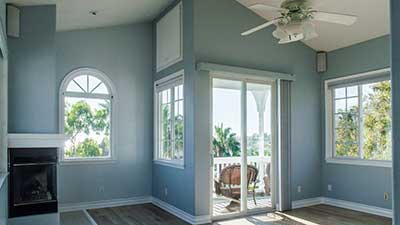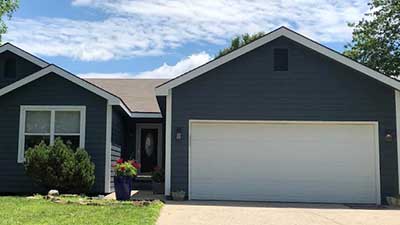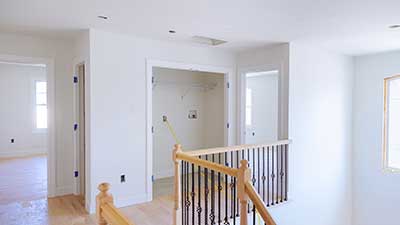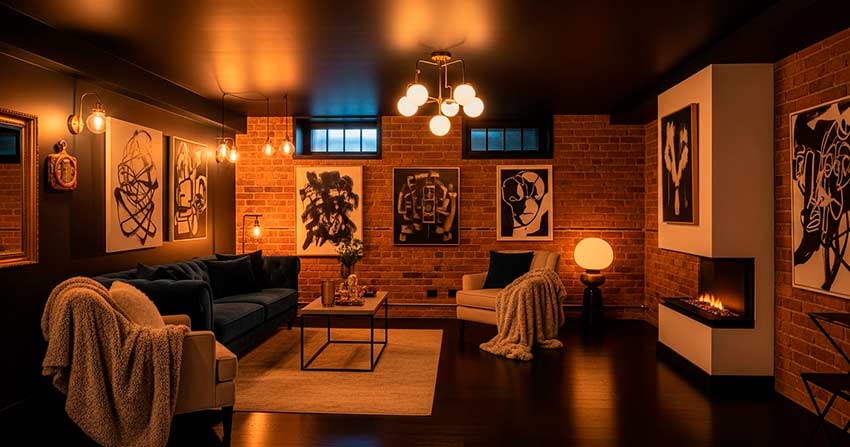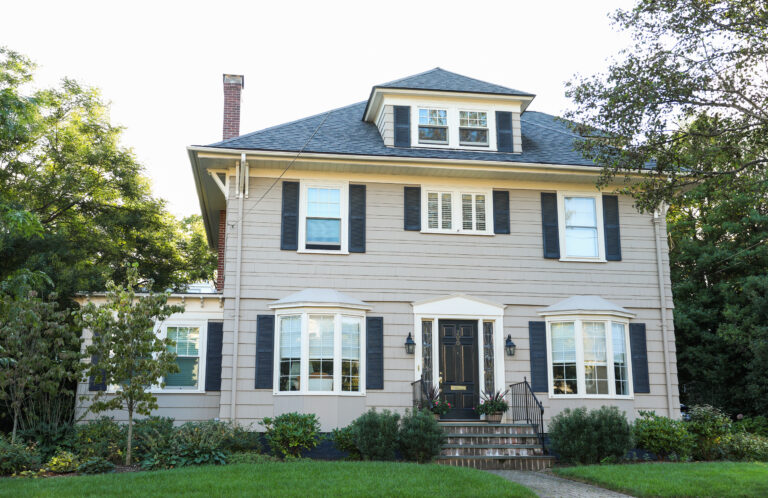Black ceiling paint has become one of the most striking design trends in modern interior design. This bold choice transforms ordinary rooms into sophisticated spaces that feel both dramatic and inviting. More homeowners are discovering how a black ceiling can solve common design challenges while creating a unique focal point that guests remember.
Painting ceiling black offers practical benefits beyond its visual impact. The dark surface hides imperfections, conceals mechanical elements, and creates intimate atmospheres in rooms with tall ceilings. Whether you’re renovating a basement, updating a living room, or designing a home theater, black ceiling paint provides solutions that white ceilings simply cannot match.
This comprehensive guide covers everything you need to know about painting your ceiling black. You’ll learn about the best black paint options, discover design possibilities, and understand the proper techniques for achieving professional results.
Key Takeaways
- A black painted ceiling instantly transforms any room from ordinary to sophisticated, creating a dramatic visual impact that white ceilings simply cannot achieve.
- Higher gloss paint should be avoided for black ceilings as it creates unwanted reflections – stick with flat black or matte finishes for the best light-absorbing effect.
- Black ceiling paint excels at hiding imperfections, pipes, and ductwork while making tall ceilings feel more intimate and cozy.
- The contrast between painted black ceilings and lighter walls black creates stunning visual depth that enhances any room’s architectural features.
- Charcoal gray primer is essential when painting over light surfaces to reduce the number of black paint coats needed for full coverage.
- For complex ceiling projects with exposed beams or extensive ductwork, hiring OnDemand Painters to paint your ceiling black ensures professional results and proper coverage.
Why Choose Black Ceiling Paint for Your Home
Black ceiling paint creates a dramatic visual impact that transforms any room’s atmosphere. The dark ceiling draws the eye upward, adding sophisticated contrast while making walls appear taller.
Dark surfaces above create a grounding effect that makes large rooms feel more intimate and cozy. This makes black ceiling paint perfect for gathering spaces like living rooms, dining areas, and entertainment rooms.
Tall ceilings often feel cold or impersonal. A black painted ceiling visually lowers the perceived height, creating better proportions and a more inviting atmosphere.
Black ceiling paint excels at hiding problems that plague many homes. Ceiling stains, minor cracks, and surface imperfections disappear against the dark background. In basements, black paint conceals pipes, ductwork, and structural elements that would otherwise create visual clutter.
The design versatility of black ceiling works with various decorating styles. Modern spaces gain a sophisticated edge, while traditional rooms acquire unexpected drama.
Best Black Paint Colors for Ceiling Projects
Choosing the best black paint for your ceiling requires understanding that not all black paints are equal. Different formulations create varying effects, with some appearing warmer or cooler depending on their undertones. The right choice depends on your room’s lighting, existing colors, and desired atmosphere.
Top Sherwin Williams Black Paint Options
Sherwin Williams offers several excellent black paint options for ceiling projects. Caviar SW6990 provides true, deep black that works perfectly in modern spaces seeking maximum drama. This color has minimal undertones, creating pure black that absorbs light effectively. Iron Ore SW7069 offers a softer approach with subtle gray undertones that complement transitional design styles.
Tricorn Black SW6258 delivers another pure black option with excellent coverage properties. This color works well in contemporary settings where you want crisp contrast against white walls. For something unique, Urbane Bronze SW7048 provides sophisticated black with bronze undertones that add warmth to the space feel.
Benjamin Moore Black Paint Excellence
Benjamin Moore also produces exceptional black ceiling paint options. Their classic Black 2132-10 remains a reliable choice that works in virtually any setting. This timeless color provides consistent coverage and depth that creates the perfect backdrop for any design style. Wrought Iron 2124-10 offers deep black with slight blue undertones that complement cooler color schemes.
Midnight 2131-20 from Benjamin Moore creates warmth that makes black ceiling feel inviting rather than stark. This color works particularly well in rooms where you want the dramatic effect without feeling overwhelmed by darkness.
Why Paint Quality Matters
Paint quality matters significantly when painting your ceiling black. Premium paints from Sherwin Williams and Benjamin Moore provide better coverage, requiring fewer coats to achieve rich, uniform color. The investment in quality paint pays off through easier application and superior long-term appearance.
Transforming Your Basement Ceiling with Black Paint
Your basement ceiling might be the perfect place to try this trend. Most basement ceiling areas feature exposed joists, ductwork, pipes, and mechanical elements that create visual chaos. Traditional drop ceiling solutions often make the space feel lower and cramped.
Black paint changes everything. When you paint your basement ceiling black, all those pipes and ducts simply disappear into the darkness. The industrial feel becomes intentional rather than accidental.
Lower ceilings painted black feel cozy rather than cramped. The dark surface creates intimacy that makes your basement feel like a retreat instead of an afterthought.
Painting your basement ceiling black also solves practical problems. Black paint hides imperfections while creating a clean backdrop for lighting fixtures.
Step-by-Step Guide to Painting Your Ceiling Black
Getting professional results when painting your ceiling black requires proper planning and technique. The process differs significantly from typical wall painting because you’re working overhead and black paint shows every mistake.
Step 1: Room Preparation
Remove everything possible from the room and cover remaining items with plastic sheeting rather than cloth drop cloths. Black paint spatters are nearly impossible to remove from fabric. Take down light fixtures, ceiling fans, and any removable trim. This extra effort prevents costly mistakes and ensures clean lines.
Step 2: Surface Preparation
Clean the ceiling thoroughly to remove dust, cobwebs, and any grease or stains. Small imperfections that disappear under white paint become visible under black. Fill holes and sand rough spots before moving to the primer stage.
Step 3: Apply Primer
Use high-quality primer tinted gray to reduce the number of paint coats needed. This step is especially important when painting over white or light-colored surfaces. Primer makes the difference between a mediocre result and professional finish.
Step 4: Choose Your Application Method
Most professionals recommend spraying for the smoothest finish, especially on textured surfaces or exposed basement ceiling elements. Rolling works for smooth drywall but requires excellent technique to avoid lap marks. For complex ceiling projects with exposed beams or extensive ductwork, hiring professionals like OnDemand Painters ensures proper coverage and finish quality.
Step 5: Apply Paint Coats
Plan for two coats minimum. The first coat will look patchy and concerning – this is normal. Apply the first coat in one direction and the second coat perpendicular for even coverage. The second coat creates the rich, uniform black that makes the dramatic impact you want.
Black Painted Ceiling Design Ideas and Wall Color Combinations
The magic happens when you pair your black ceiling with the right wall colors and design elements. White walls create the most dramatic contrast, making both the ceiling and walls appear more vibrant. This combination works beautifully in modern and traditional spaces alike.
Painting your ceiling black while keeping walls white also maximizes natural light reflection from the walls while the ceiling absorbs unwanted glare. This balance creates comfortable lighting conditions perfect for entertaining or relaxing.
In open floor plans, black ceiling sections define different areas without physical barriers. Paint the dining area ceiling black while leaving the kitchen ceiling white to create visual separation. This technique helps organize large spaces while maintaining the flowing feel that makes open floor plans so appealing.
Crown molding and architectural details pop against black ceiling backgrounds. The contrast makes these features appear more prominent and adds visual interest to rooms that might otherwise feel plain. Consider adding crown molding specifically to enhance the black ceiling effect.
Lighting becomes even more important with black ceiling choices. The dark surface won’t reflect light like white ceilings, so plan additional fixtures or brighter bulbs. However, this creates opportunities for dramatic lighting effects that white ceilings can’t achieve. Pendant lights, chandeliers, and recessed fixtures create beautiful contrast against the black background.
Avoiding Common Black Ceiling Paint Mistakes
The biggest mistake homeowners make is choosing the wrong paint finish. High-gloss or semi-gloss black paint creates unwanted reflections that highlight every imperfection. Stick with flat or matte finishes that absorb light rather than reflecting it. Some homeowners prefer satin finish in high-humidity areas like bathrooms, but flat black delivers the most dramatic effect.
Inadequate surface preparation shows more with black paint than any other color. Take time to properly clean, prime, and repair the ceiling before painting. Small shortcuts create big problems that are expensive to fix later.
Many people underestimate how much paint they need for black ceiling coverage. Black paint typically requires more coats than lighter colors, especially over white surfaces. Buy extra paint to avoid running out mid-project and having to match color later.
Poor lighting planning creates the most regret after painting the ceiling black. The dark surface changes how light moves through your room. Test your lighting with temporary fixtures before finalizing the paint job to ensure you’ll be happy with the results.
Transform Your Space with Confidence
Painting ceiling black represents one of the most dramatic changes you can make to any room. This bold choice creates a sophisticated atmosphere while solving practical problems that plague many homes. Whether you’re updating a single room or planning a whole-house renovation, black ceiling paint offers unique benefits that traditional colors simply cannot match.
The key to success lies in proper planning, quality materials, and careful execution. Take time to choose the right shade of black for your space and lighting conditions. Prepare surfaces thoroughly and use premium paint for the best results.
Whether you tackle this project yourself or work with experienced professionals like OnDemand Painters, a black ceiling can transform your space from ordinary to extraordinary. Start with one room to test the dramatic effect, and you might find yourself planning black ceilings throughout your home.
FAQs
Is painting a ceiling black a good idea?
A black painted ceiling creates dramatic sophistication while hiding imperfections and making tall rooms feel more intimate and cozy.
What are the cons of black ceilings?
Black ceilings require more coats of paint, careful lighting planning, and meticulous surface preparation since imperfections show more easily.
What does painting the ceiling dark do to a room?
Dark ceilings visually lower the perceived height, create intimate atmosphere, and draw attention to architectural features while absorbing unwanted light reflections.
Why add black to ceiling paint?
Adding black to your ceiling paint creates striking contrast, hides mechanical elements, and transforms ordinary spaces into sophisticated retreats.
What paint finish should I use for a black ceiling?
Use flat black paint finish to minimize reflections and achieve the dramatic light-absorbing effect that makes black ceilings so striking.
How many coats does a black painted ceiling need?
Most black painted ceiling projects require two coats minimum for rich, uniform coverage, especially when painting over white or light surfaces.






